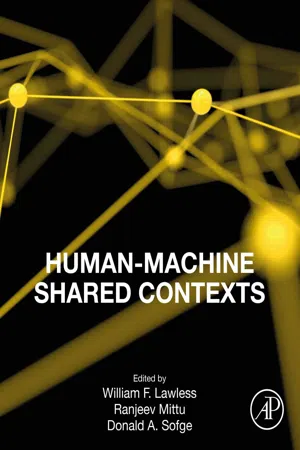
- 438 pages
- English
- ePUB (mobile friendly)
- Available on iOS & Android
Human-Machine Shared Contexts
About This Book
Human-Machine Shared Contexts considers the foundations, metrics, and applications of human-machine systems. Editors and authors debate whether machines, humans, and systems should speak only to each other, only to humans, or to both and how. The book establishes the meaning and operation of "shared contexts" between humans and machines; it also explores how human-machine systems affect targeted audiences (researchers, machines, robots, users) and society, as well as future ecosystems composed of humans and machines.
This book explores how user interventions may improve the context for autonomous machines operating in unfamiliar environments or when experiencing unanticipated events; how autonomous machines can be taught to explain contexts by reasoning, inferences, or causality, and decisions to humans relying on intuition; and for mutual context, how these machines may interdependently affect human awareness, teams and society, and how these "machines" may be affected in turn. In short, can context be mutually constructed and shared between machines and humans? The editors are interested in whether shared context follows when machines begin to think, or, like humans, develop subjective states that allow them to monitor and report on their interpretations of reality, forcing scientists to rethink the general model of human social behavior. If dependence on machine learning continues or grows, the public will also be interested in what happens to context shared by users, teams of humans and machines, or society when these machines malfunction. As scientists and engineers "think through this change in human terms, " the ultimate goal is for AI to advance the performance of autonomous machines and teams of humans and machines for the betterment of society wherever these machines interact with humans or other machines.
This book will be essential reading for professional, industrial, and military computer scientists and engineers; machine learning (ML) and artificial intelligence (AI) scientists and engineers, especially those engaged in research on autonomy, computational context, and human-machine shared contexts; advanced robotics scientists and engineers; scientists working with or interested in data issues for autonomous systems such as with the use of scarce data for training and operations with and without user interventions; social psychologists, scientists and physical research scientists pursuing models of shared context; modelers of the internet of things (IOT); systems of systems scientists and engineers and economists; scientists and engineers working with agent-based models (ABMs); policy specialists concerned with the impact of AI and ML on society and civilization; network scientists and engineers; applied mathematicians (e.g., holon theory, information theory); computational linguists; and blockchain scientists and engineers.
- Discusses the foundations, metrics, and applications of human-machine systems
- Considers advances and challenges in the performance of autonomous machines and teams of humans
- Debates theoretical human-machine ecosystem models and what happens when machines malfunction
Frequently asked questions
Information
Introduction: Artificial intelligence (AI), autonomous machines, and constructing context: User interventions, social awareness, and interdependence
b Information Management & Decision Architectures Branch, Information Technology Division, US Naval Research Laboratory, Washington, DC, United States
c Navy Center for Applied Research in Artificial Intelligence, US Naval Research Laboratory, Washington, DC, United States
Abstract
Keywords
1.1 Introduction
1.1.1 Overview
1.1.2 Problem 1: The generation of new data
1.1.3 Problem 2: Explanations by machines of what they have learned or can share (building context)
Table of contents
- Cover image
- Title page
- Table of Contents
- Copyright
- Contributors
- Preface
- Chapter 1: Introduction: Artificial intelligence (AI), autonomous machines, and constructing context: User interventions, social awareness, and interdependence
- Chapter 2: Analogy and metareasoning: Cognitive strategies for robot learning
- Chapter 3: Adding command knowledge “At the Human Edge”
- Chapter 4: Context: Separating the forest and the trees—Wavelet contextual conditioning for AI
- Chapter 5: A narrative modeling platform: Representing the comprehension of novelty in open-world systems
- Chapter 6: Deciding Machines: Moral-Scene Assessment for Intelligent Systems
- Chapter 7: The criticality of social and behavioral science in the development and execution of autonomous systems
- Chapter 8: Virtual health and artificial intelligence: Using technology to improve healthcare delivery
- Chapter 9: An information geometric look at the valuing of information
- Chapter 10: AI, autonomous machines and human awareness: Towards shared machine-human contexts in medicine
- Chapter 11: Problems of autonomous agents following informal, open-textured rules
- Chapter 12: Engineering for emergence in information fusion systems: A review of some challenges
- Chapter 13: Integrating expert human decision-making in artificial intelligence applications
- Chapter 14: A communication paradigm for human-robot interaction during robot failure scenarios
- Chapter 15: On neural-network training algorithms
- Chapter 16: Identifying distributed incompetence in an organization
- Chapter 17: Begin with the human: Designing for safety and trustworthiness in cyber-physical systems
- Chapter 18: Digital humanities and the digital economy
- Chapter 19: Human-machine sense making in context-based computational decision
- Chapter 20: Constructing mutual context in human-robot collaborative problem solving with multimodal input
- Index